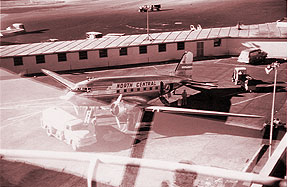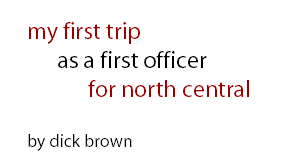

I was hired by North Central Airlines on April 15, 1959. I came on the line in early May after two weeks of ground school, check out in the DC-3 and several line trips as an observer to see how everything worked out in the real world.
I reported for duty at MDW (Chicago-Midway Airport) operations at 1600 for a 1700 departure. I met my captain and stewardess. The captain watched me make out the flight plan and together we checked the weather and other data that might concern the flight from MDW to MKE (Milwaukee).
The captain had checked out just a few months before, so for him this was not his first flight. Later on that summer, I would fly with several brand new captains. But because of a strong emphasis on STANDARDIZATION of procedures, we very seldom ever ran into conflicts. The company set the standards and we were expected to follow procedures OR ELSE find work else where. For the most part, I would say that was how it was.
About :20 prior to departure we went out to the aircraft. The captain did the exterior pre-flight inspection while I did the interior. The smell of raw 90 and 100 octane aviation fuel fumes drifted in and out of the ramp area. The interior of these piston engine aircraft, while at the gate, often times held some of the ramp area odors; that is how it was, back when flying was something you really felt throughout your whole body.
Our DC-3s were equipped with an air stair door located on the left rear of the fuselage. NCA obtained it's aircraft from several sources. The first were from TWA and then Delta as the main sources. There were several from Eastern (EAL) and two from the U S Navy. When I went to work for NCA, they had the largest fleet of DC-3s in the world, numbering 32 aircraft. All were standardized throughout, especially in the cockpit. The NCA aircraft were equipped with Wright R-1820 engines, de-ice boots on the wings and stabilizer, with alcohol to de-ice the props, carburetors and windshield. We seldom used the carb alcohol. Since the windshield did leak a little, we were provided with plastic aprons to lay across our laps and when we ran the alcohol on the props and windshield, the cockpit took on the smell of a brewery. Fuel tanks consisted of three 200 gallon tanks... main & aux. tanks on the left with just a main tank on the right side. We never operated both engines from one tank unless it was an emergency situation. Most fuel loads were just full mains. The max gross take-off weight was 25,346 pounds. Our aircraft were configured with 26 seats, however on the two navy birds, we had 28 seats. The arrangement was two seats on each side of the isle. There were several air circulation fans located in the overhead rack area. The avionics consisted of single VHF and HF transceivers for voice communication, dual VOR/ILS, dual ADF and a marker beacon for navigation. Since this was still the vacuum tube era, the radio rack did provide a real "toasty" temperature situation year 'round. We also had heated windshields.....hot air on the captain's side and electric on the F/O's side. Heat for the cabin and cockpit was provided by a single Janitrol gas heater located on the right side of the area just behind the cockpit, between the two right front cargo bins. The radio rack was on the left side of the forward companion way, just behind the front cargo door and immediately in front of the forward left cargo bin. Sorry, no air conditioning. We just opened the side cockpit windows after we were at cruise altitude. We did have ram air from an air intake in the nose that kept us cool, once we were in the air.
In those days, NCA operated VFR (visual flight rules) except when actual IFR (instrument flight rules) conditions existed. The captain gave me a few clues as to what the ATC clearance would consist of on this first trip. Such as, "ATC clears North Central 17 to the MKE airport via left turn after takeoff to 090, radar vector to V7E (a low altitude airway), flight plan route, climb to and maintain 3,000', contact departure control on 125.0. Our ATC clearance would be issued during the taxi out procedure. Obtaining an ATC clearance was a real experience in those days. Hang on and I'll share that with you too.
The passengers were loaded. At that time of day (1700), we were usually full, or nearly so. With the cargo and fuel load, our weight was usually in the 24,000 to 25,000 pound area. We were all buttoned up, and the agent gave us "clear right". I double checked the right prop area and I confirmed "clear". The captain set the parking brake, switched on the fuel boost pump for the RT engine and engaged the starter. After the engine was turning over, the captain switched on the ignition and gave it a shot of primer. When the engine caught, I pulled the mixture into auto rich. On our Wright engine set up, the carb heat control was on top of the center pedestal, to the right of the throttles. The mixture controls were adjacent to the right fuel selector with 4 positions......Idle cut off (full forward position), auto lean, auto rich and emergency rich. The start procedure was repeated for the left engine and after the ground power was disconnected, we got the "wave off" from the agent and I called ground control for taxi.
Recall this was 1700; the "evening push" was about to begin. We would join in a "daisy chain" of aircraft heading west out of the terminal area, right turn on to the north/south taxi way, crossing runways 22 L/R, west on the north ramp to hold short of runway 13L. But hold everything! UAL, EAL, DAL, TWA, AA, CAP, CAL, NWA, BNF, OZA and even LCA (Lake Central) had departures too. There would be 4 or 5 United DC-6s & 7s and CV-340s, the same for American and Delta, while TWA & EAL would be putting up Connies and Martin 404s and Northwest would have a B-377 Stratocruiser or a DC-4, 6 or 7. Capital (CAP) would be launching a Connie, DC-4 and a couple of Viscounts, not to mention several other NCA flights. There could easily be 30 to 35 piston engine machines departing at that time of the day with the line up really something to behold. The smell of the exhaust from these piston engines was indescribable. Completing the engine run up was a real challenge and sitting behind a 4 engine aircraft during his run up was a REAL experience. I completed the taxi and before takeoff check lists and the captain accomplished our "run-up" and engine checks which consisted of exercising the props, checking the prop feathering system (on initial departure) checking the carb heat (in winter) and finally the magneto check.
Well, anyway, you have the picture. Lots of HEAVY IRON all moving at once. Lots of "round engines" creating a melody that even Beethoven could never duplicate. The time from taxi out to actual takeoff might easily be :45 to :50, especially if the field was socked in with real dirty IFR weather. Now, NCA 17 is in the line up and the ground controller has established the line up as it exists. He will issue a temporary gate hold until the line moves up a little. During this pause in the operation he begins to issue the ATC clearances. It went something like this: Ground Control -"The following flights listen for your IFR clearances and read them back in the order given. ATC clears United 723 to the DEN airport...........ATC clears TWA 452 to the Kansas City airport.........ATC clears American 124 to the Tulsa airport.........ATC clears North Central 17 to the MKE airport........ATC clears Capital 654 to the CLE airport...... Go ahead United 723 with your read back!" They usually issued the clearances in batches of 5 or 6 at a crack and heaven help the F/O (first officer) who "muffed" his read back! And so the process went. After a batch of clearances were read and acknowledged, then another group of aircraft would be issued taxi instructions followed by ATC clearances.
During this period of time, NCA was experiencing some plug fowling problems, especially with the excessive ground times. The procedure that the company had instituted to help to alleviate this situation was to move the mixture from the auto rich position forward through the auto lean detent and on toward the idle cut off position, thus leaning out the fuel flow to the engine and keeping it from loading up. But still the fouling situation remained a concern. The captain would also run the engines up several times during the ground delay in an attempt to keep the engine "cleaned out".
Well, it was finally our turn and we were cleared into position on 13L. I quickly double checked that all items on the Taxi & Before TO checklists were completed, then went to the Takeoff checklist......Cowl flaps - trail, mixture control back to the auto rich position. The captain locked the tail wheel and we were cleared for takeoff! The captain pushed the throttles forward and the engines responded immediately. The tail came off the ground within a few moments as the bird gained speed. The captain let the yoke assume a neutral position as the aircraft accelerated. We broke ground and the call for "gear up" was given; I responded by unlocking (pulling back) the lock lever on the cockpit floor and then positioning the gear lever to the up position. We were perhaps 100 to 200 feet in the air when the right engine began to backfire. Over the roar of the engines and backfiring the captain shouted......"DON'T TOUCH ANYTHING"! Well, I was disciplined enough to recognize that if anything was to be done, the captain would so order it. Besides, a quick once over of the engine instruments showed nothing to be wrong; the airspeed was increasing, and most important, the directional control of the aircraft did not seem to be a problem. At the same time, the captain pulled back just a "wee bit" on the right throttle and the backfiring stopped immediately. This all took place with a matter of a few seconds. But I shall never forget it. And that was the beginning of what was to be a career that lasted 35 years and 4 months, accumulating over 20,000 flight hours......without interruption.
In future writings, I would like to take you with me as we fly across the "north country" into un-controlled airspace as it existed in the late 1950's and into the mid 1960's. The 5,000 foot, single runway airports that served so many of the small communities into which North Central operated, in all sorts of winter weather. Also, winter operations in Lower Michigan, the "snow machine" of the mid-west. So stay tuned for more North Central stories from the past.
copyright 2007 - Richard A. Brown
